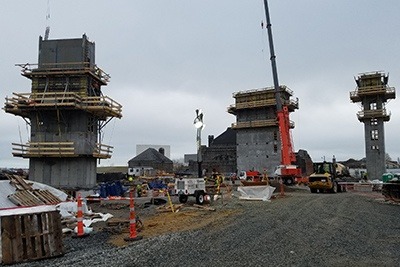Colleges and universities are under tremendous pressure to provide attractive and modern facilities as competition for students and faculty alike increases. This can mean building on contaminated land, whether it’s already part of campus, or acquiring land previously used for industrial or other purposes. When fulfilling your campus expansion mission includes the development of contaminated property, you need to understand the cost and schedule impacts of addressing any environmental conditions required to make it safe for its future use. It’s important to get these costs into the pro forma up front.

Based on my experience, one of the most critical considerations is understanding how the environmental due diligence and remediation process is regulated in your region and its impact on your plans. I’ve had a lot of experience with assessments in the Northeast, where several states (MA, NJ, and CT) take a semi-privatized approach. Under this framework, licensed environmental professionals — rather than the state regulators — assess risk and make recommendations regarding site cleanup. And this changes the way the work is conducted. One key advantage is that owners do not have to wait for regulatory approval, which allows projects to proceed faster — helping schedule and potentially budget.
This framework also places greater responsibility on you and on environmental professionals with specialized expertise. Because of that, it is critical to find a team that understands what you are trying to achieve and can effectively act. In Massachusetts, for example, Licensed Site Professionals (LSPs) are tasked with assessing oil and hazardous material contamination and associated risk and site cleanup implementation based on the Massachusetts Contingency Plan.
What is the most effective way to approach the semi-privatized regulatory environment for property development? Here are seven things you can do:
1. If you are buying property, go beyond site assessment to true due diligence. Taking a strategic approach to understanding the potential property acquisition’s environmental conditions is critical for buyers. Approaching the initial assessment of oil and hazardous materials strategically from the outset can result in significant time, money, and resource savings – from geotechnical design and soil management to evaluation of remediation alternatives and excavation methods. It helps to begin these assessments with the end-point in mind, considering how a property will be used, and how that will impact the site assessment scope, property sale price and potential future mitigation.
2. On your own property, you still need to do your homework. While some amount of information will be available as part of a property transaction, it’s common to have no site assessment report or specific environmental information on your existing property, and then be surprised during construction. A better approach is to conduct your own internal due diligence tailored to the needs of your planned project. This may include anything from a paper study to extensive soil and groundwater testing.
3. Take a holistic approach to save time and money. Consider all aspects of the project and how each area will impact the others. For example, the level of contamination in the groundwater and soil will affect how and where any excess soil is disposed of and which soil brokers will accept it. By being knowledgeable about all aspects of the project, you can provide contractors with detailed project scope and specs in advance, enabling them to develop more accurate bids, minimizing inflated costs, overruns and the need to re-work tasks down the line.
Integrating the underground work, such as geotechnical (design, foundation), soil management, and mass excavation, can help maximize efficiency and cost-effectiveness. Also, keep in mind that the team’s work doesn’t stop after the project is complete. Include a legal expert on the team to explore potential tax credits once the project is complete.
At Yale University, soil is managed at the campus scale to minimize costs, with one project delivering suitable excess soil to another to avoid import and export costs. Yale also takes the opportunity to use excess soil to satisfy recognized needs, such as creating much-needed additional parking and constructing stormwater retention basins at the golf course.
4. Put the right team in place to derive the greatest value. Bring in an integrated team of experts, who can provide the professional insights you need. They will know the what, who, how, and when. The right team will also know where you should sample and how often, and what to do when you get a certain result. They will know the facilities that can accept the soil, and what their volume capacities are at certain times of the year, so you can budget and plan the construction accordingly.
If the team has worked on a lot of projects in the area, they might already have information on adjacent properties, which would save the time and expense of encountering unknown conditions. A knowledgeable, experienced team will help you make good decisions based on best practices and the latest industry expertise.
5. Focus on facilitation and consensus. Conduct meetings with key stakeholders, such as the project owner, contractor, and architect, to make sure everyone is on the same page, engaged, and has a shared vision. It is also critical that they share information to avoid the need to re-work tasks.
If there are many stakeholders involved, collaboration is more important than ever. For example, when Northeastern University was constructing a building located across the train tracks from its main campus and wanted to build a connecting footbridge, they had to collaborate with the Mass Bay Transit Authority to be aware of land ownership and potential environmental issues.
6. Understand all the details of the construction schedule. By understanding all the steps involved throughout the project, you can more accurately determine what’s realistic and what needs to be adjusted to manage project expectations. The contractor’s pull plan should clearly identify soil excavation and other remediation activities that will impact other work. It also needs to include accurate soil volume estimates up front so that soil can be adequately characterized prior to excavation.

7. Use innovative approaches to create efficiencies and greater value. For example, as the University of Massachusetts Boston transitions from a commuter to a residential campus, it is in the process of constructing their first student residence halls on a former landfill. The project was designed to maximize on-site reuse of soil and design a sub-slab vent system with crushed stone and vent piping, which will provide cost-effective passive mitigation that could easily be upgraded to an active system, as needed.
It pays to do your homework. And by taking a strategic, holistic, collaborative and creative approach to the regulatory process, you will be able get the best value for your campus development projects, not only meeting safety standards and regulatory compliance, but also saving significant time and money in the long run.
To discuss how these ideas relate to environmental challenges at your university, contact Cole Worthy.
Published: 5/25/2017
- Education, healthcare, and cultural institutions
- Higher education
- Contaminated site management
- Environmental due diligence
- Remediation
- Support of excavation design
- Foundation design
- Geotechnical engineering
Author

Senior Associate, Program Manager




